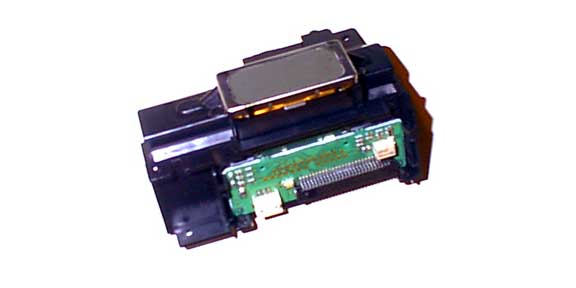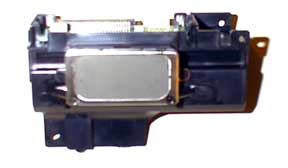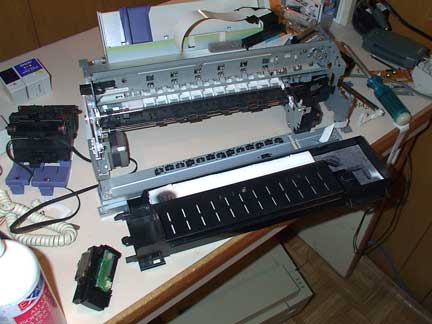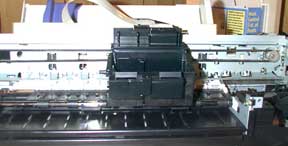| InkJet Printers |
 |
| FTLComm - Tisdale - February 9, 2001 |
| The picture above it the key element in Epson's remarkable 1400 dot per inch print technology. When we all began the swing from type writers to computers and word processors the first printers were actually transferred technology with murderously slow daisy wheel impact printers and the early dot matrix printers were so poor in quality that manufacturers used terms like "near" to describe the appalling print. In the early 80s college professors demanded that material be handed in "typewritten" and refused to accept dot matrix print outs. Dot matrix printers are still the work horses of commerce where massive numbers of copies are churned out but the mid 80s saw the introduction of the laser printer. |
| Laser printers borrowed the technology from copy machines and produced a whole new industry, desktop publishing based on the early Macintosh computers. The laser print produces thousands of copies in astonishing quality but in black print only. |
| It was in the early nineties that Canon introduced its bubblejet printers that used microscopic jets of quick drying ink to paint on paper. Hewitt Packard pioneered colour printing using this same idea and both continue to produce excellent printers to this day. The key to the inkjet printer is not the printer or its ink but the paper on which you print. Hard non-absorptive surfaces like clay coated papers produce amazing crisp reproductions and then came Epson. |
 Using the technology to produce the print head shown at the top of the page Seiko/Epson who had been one of the most prolific manufacturers of the dot matrix era made a great leap from the 600dpi capability of Canon and Hewitt Packard to 1440 dots per inch. Their first Stylus printers were the pride of their owners because by using photographic quality paper these things could turn out photographs. Epson continues to produce these printers all based on the same concept, with some using four and six colour ink but most sticking to three colours and black. The price for the early high quality stylus printers though about one third the price of a laser printer was still almost four hundred dollars. But not since the production of the early Polaroid cameras has there been a product that has been essentially little more than a license to print money. The inkjet manufactures discovered that the supplies for these things made so much money they could actually give the printers away. In some cases they have. |
 Lexmark printers are priced so low that they are actually sold at or about the cost of production and one company Apollo had a printer out that when bought with a computer at a Winnipeg store actually ended up giving the customer $15 to buy it. The whole issue with inkjet printers is alcohol. The tiny little ink tanks on these printers contain a sponge with an ink mixture in it, that ink is mostly alcohol thus explaining its quick drying. An ink cartridge in a printer lasts about a month, if you use it or not and Epson's cartridges will cost you sixty dollars to change those to cartridges. If you use the printer regularly it will produce excellent even amazing results. But if you have an office like mine where the laser printer handles the plain text and the colour inkjet printer is used only to do pictures, there is trouble brewing. |
| My Epson 740 refused to print properly, I did the cleaning routine for some time and installed new Epson Cartridges but I was getting all of its lights blinking in unison. It several hours of patient searching on their |
| web site to discover that the answer the problems was not there. Then a call to there tech support (not a toll free number) resulted in a twelve minute wait then I gave up and went to an automated help line and another fifteen minutes to discover that I had to go back to the tech support number. Another fifteen minutes and a lady with an unintelligible French accent had me do a couple of tests and then pronounced it needed to go to a repair shop. The closest repair centre is in Winnipeg and when I add the basic repair fee, and cost of shipping it looks like about $100 and a new version of the 740 which cost me $350 (dealer price) can now be purchased for $130 so all of this was pointless. |
| With this in mind I thought you and I would like to know how it works so it was time to sacrifice (above) the 740. |
| One of the mysteries for me is what happens to all that ink when you clean the heads. Well you can waste a lot of ink doing that and it simply goes into a plastic tray about the size of the bottom of the printer where the alcohol evaporates. |
 I felt that if a physical problem was to be found it would be the print head and I resolved to get to the bottom of it and from the picture at the top of the page you can see I was able to take the tank assembly appart and reveal the print head which was really dirty. Using alcohol I cleaned it up but my hands will be a few days recovering. The most complex part of disassembling and reassembling the 740 was the plastic parts that snap and fit together. Both those that hold the shaft that the tank system moves back and forth across the work area and the tank unit itself (shown on the left). |
 In the end I cleaned it all up and put it all back together with only two pieces left on the counter. A screw and a little rectangle of felt that mysteriously appeared and seemed to have no home. Once back together the electronics components re-connected it was turned on and nothing had been achieved. Well that is not exactly true, I have seen the inside of this remarkable printer and have a better understanding of its function but the main problem is imbedded in its electronics. The main curcuit board and sensors all could be a part of this ones problem and a new one has been ordered. |
 The thing that annoys me more than anything is that not only to I have to replace this printer with a new one but I loose the costly new ink cartridges just installed. Manufacturers need to be scolded for making machines that are replaced rather than repaired and we are all losers when it comes to inkjet printers and their costly operating cost with cartridges running at $60 a refill and if you are doing pictures that amount of money will get you about fifty pictures with the paper itself costing almost a dollar a print. What then is the solution? If we want colour there isn't a solution. There are some really interesting wax colour printers that produce amazing results but the copies have a limited life and these printers are thousands, not hundreds of dollars. Laser colour printers up until now have cost about a dollar a page and the least expensive ones are about $2000 producing copy that is less than the quality of the inkjet printers. There are a few of the newer colour laser printers starting to show up in the area and we will get you a report on them after some experience with them tells us about their use and cost effectiveness. |
| Timothy W. Shire |